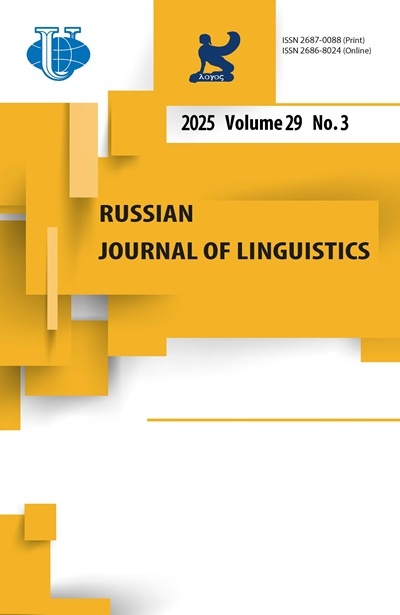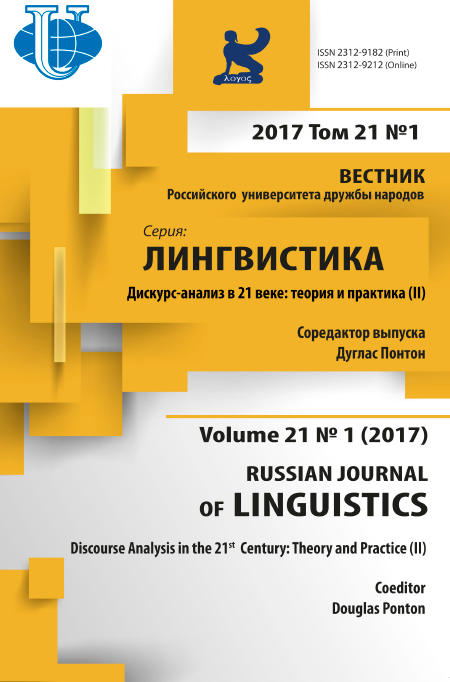Дискурс убеждения: риторические и дискурсивные практики в президентской избирательной кампании Рухани и победа его принципа благоразумия и надежды
- Авторы: Мирзаи А.1, Еслами З.R2, Сафари Ф.1
-
Учреждения:
- Университет Шахре-Корд
- Техасский университет A&M в Катаре (США)
- Выпуск: Том 21, № 1 (2017): Дискурс-анализ в 21 веке: теория и практика (II)
- Страницы: 161-182
- Раздел: Статьи
- URL: https://journals.rudn.ru/linguistics/article/view/15410
- DOI: https://doi.org/10.22363/2312-9182-2017-21-1-161-182
- ID: 15410
Цитировать
Полный текст
Аннотация
В попытке приобрести и сохранить власть политики используют в своих выступлениях определенные риторические и языковые средства, чтобы привлечь избирателей на свою сторону. Настоящее исследование явилось попыткой изучения риторических и дискурсивных средств убеждения, использованных Хасаном Рухани в предвыборной кампании на пост президента Ирана. Особое внимание было уделено изучению языковых средств различных уровней, составивших основу его политического дискурса. В центре внимания оказались:1) фонетические особенности его речи, 2) выбор лексических средств, 3) особенности синтаксических структур, использованных для передачи политических нюансов. В исследовании применялся критический дискурс-анализ (КДА), опирающийся на трехмерную аналитическую парадигму Фэйрклафа (Fairclough 2010), с целью исследовать отношения дискурса и власти в речи Рухани, с одной стороны, и социально-культурные, религиозные и политические ценности, лежащие в основе риторических средств - с другой. Результаты показали, что политический дискурс Рухани включает различные риторические и дискурсивные средства, такие как трехчленные конструкции, повторения в параллельных конструкциях, аллитерацию и метафоры, влияющие на общественное мнение. Более того, использование кратких и лаконичных тезисов, визуальных символов и динамических метафор помогло ему обратиться к публике с высокой долей эмоциональности и привлечь значительный электорат.
Об авторах
Азизулла Мирзаи
Университет Шахре-Корд
Email: fazizullah@yahoo.com
8 University str., 8818634141, Шахре-Корд, Иран
Зохрэ R Еслами
Техасский университет A&M в Катаре (США)
Email: zeslami@tamu.edu
363 Harrington Office Building, 23874, Доха, Катар
Фатима Сафари
Университет Шахре-Корд
Email: f_19safari@yahoo.com
Список литературы
- Al-Ahram Weekly online. 18 -24 June 2009. Issue No. 952
- Atai, M., & Mozaheb, M. (2013). The representation of Iran’s nuclear program in British newspaper editorials: A critical discourse analytic perspective. International Journal of Society, Culture, and Language, 1(2), 15-33
- Biria, R., & Mohammadi, A. (2012). The socio pragmatic functions of inaugural speech: A critical discourse analysis approach. Journal of Pragmatics, 44(10), 1290-1302
- Bobin, J.P. (1988). Le marketing politique: Vendre L’Homme et L’Idée [Political marketing: How to sell a man and an idea]. Paris: Milan Media
- Bonyadi, A. (2010). The rhetorical properties of the schematic structures of newspaper editorials: A comparative study of English and Persian editorials. Discourse & Communication, 4(4), 323-342
- Capone, A. (2010). Barack Obama's South Carolina speech. Journal of Pragmatics, 42(11)
- Charteris-Black, J. (2004). Corpus approaches to critical metaphor analysis. Hampshire/New York: Palgrave Macmillan
- Charteris-Black, J. (2011). Politicians and rhetoric: The Persuasive power of metaphor. Basingstoke: Palgrave Macmillan
- Chilton, P. (2004). Analyzing political discourse. Theory and practice. London: Routledge; 2964-2977
- Cheng, M. (2006). Constructing a new political spectacle: Tactics of Chen Shui-bian's 2000 and 2004 inaugural speeches. Discourse and Society, 17(5), 583-608
- Fairclogh, I. & Fairclough, N. (2012). Political discourse analysis: A method for advanced students. London and New York: Roultedge
- Dedaić, M.N. (2006). Politeness speeches and persuasive Argumentation’. In Keith Brown (ed.) Encyclopedia of Language and linguistics, Vol. 9. Amsterdam: Elsevier, 700-707
- Duranti, A. (2006). Narrating the political self in a campaign for U.S. Congress. Language in Society, 35, 467-497
- Fairclough, N. (1995). Media discourse. London, New York, Sydney: Edward Arnold
- Fairclough, N. (2003). Analyzing discourse. London: Routledge
- Fairclough, N. (2010). Critical Discourse Analysis: The critical discourse analysis. London: Longman
- Fairclough, N. & Wodak, R. (1997). Critical discourse analysis. In T.A. Van Dijk (Ed.), Introduction to discourse analysis, 258-284
- Ferrari, F. (2007). Metaphor at work in the analysis of political discourse: investigating a preventive war persuasion strategy. Discourse and Society, 18(5), 603-625
- Goatly, A. (1997). The language of metaphors. London and New York: Routledge
- Horváth, J. (2010). Critical discourse analysis of Obama's political discourse. Retrieved July 4, 2013, from http://www.scribd.com/doc/39586848/.html
- Hylen, S. (2005). Allusion and meaning in John 6. Berlin: De Gruyter GmbH
- Ivanic, R. (1997). Writing and identity: The discoursal construction of identity in academic writing. Amesterdom: Benjamins
- Kress, G. (1990). Critical discourse analysis. Annual Review of Applied Linguistics, 11(1), 84-99
- Lakoff, G., & Johnson, M. (1980). Metaphors we live by. Chicago, IL: Chicago University Press
- Mutz, D., Sniderman, P., & Richard, B. (1999). Political Persuasion and Attitude Change. Ann Arbor: The University of Michigan Press
- Nianxi, X. (2009). Political Slogans and Logic. Diogenes 56 (1), 109-116
- Pennycook, P. (2001). Critical Applied Linguistics. Mahwah, New Jersey: Lawrence Erlbaum
- Obeng, S.G., & Harford, B. (2008). Topics in political discourse analysis. (Eds). Hauppauge, N.Y.: Nova Science
- Pondy, L. (1983). The role of metaphors and myths in organization and the facilitation of change. In L. Pondy, P. Frost, G. Morgan, & T. Dandridge (Eds.), Organizational symbolism. Greenwich, CT: JAI Press, 157-166
- Rezaei, S., & Nourali, N. (2016). Language and power: The use of persuasive techniques in Iran and U.S. president speeches. Journal of Language Teaching and Research, 7(6), 1203-1209
- Semino, E. (2008). Metaphor in discourse. Cambridge, New York: Cambridge University Press
- Tekin, B.C. (2008). The construction of Turkey’s possible EU membership in French political discourse. Discourse & Society, 19(6), 727-763
- Van Dijk, T.A. (1993). Principles of critical discourse analysis. Discourse and Society, 4(2), 249-83
- Vesnic Alujevic, L. (2011). Communicating with voters by blogs? Campaigning for the 2009 European Parliament elections. Discourse & Communication, 5(4), 413-428
- Wei, L., Lu, L., & Ahrens, K. (2008). Ideological influence on BUILDING metaphors in Taiwanese presidential speeches. Discourse & Society, 19(3), 383-408
- Wei, J.M. (2000). An analysis of the metaphorical usage of campaign slogans in the 1996 presidential campaign in Taiwan. Journal of Asian Pacific Communication, 10(1), 93-14
- Wells, P., & Bull, P. (2007). From politics to comedy: A comparative analysis of affiliative audience responses. Journal of Language and Social Psychology, 26(4), 321-342
- Woods, N. (2006). Describing discourse: a practical guide to discourse analysis. Hodder Arnold: London
Дополнительные файлы















